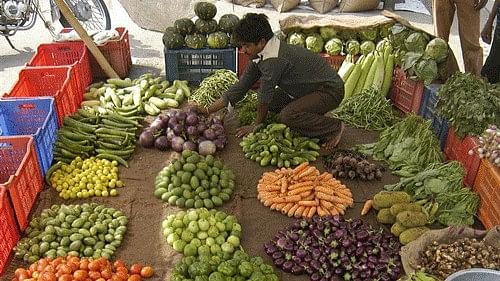
Consumers are feeling the pinch and will continue to suffer because the prices of most of the items are unlikely to go down.
Credit: Reuters File Image
India’s retail inflation, measured by the consumer price index, eased to 6.83 per cent in August from a 15-month high of 7.44 per cent in July. The decline was mainly caused by a slight decline in food inflation as seen in the fall in the consumer food price index to 9.94 per cent from 11.51per cent in July.
This was, on its part, accounted for by the fall in vegetable inflation from 37.4 per cent to 26.1 per cent, as vegetable prices have moved down from their highs. But inflation is still at elevated levels for most items in the food basket. It is above 10 per cent for cereals, pulses and spices, and above 7 per cent for milk and milk products.
Consumers are feeling the pinch and will continue to suffer because the prices of most of the items are unlikely to go down. Variations usually happen only in the case of vegetables. It should also be noted that rural inflation at 7.02 per cent continues to outpace urban inflation which, for August, was 6.59 per cent.
Even if vegetable prices fall, inflation is likely to continue to be elevated and stay above the Reserve Bank of India’s forecast of 6.2% for this quarter. This will also be above the RBI’s tolerance level. That is because of the impact of a weak monsoon on crops in several parts of the country and rising crude prices.
The rabi crop is likely to be adversely affected by the El Nino phenomenon which is gaining in strength. If food inflation remains high, it will raise the general inflation levels, too.
The government has made some supply-side interventions to keep the prices in check because it knows that a rise in food prices in pre-election months will be politically damaging. It has made open-market sale of wheat and rice and imposed stock limits on some pulses and export bans on wheat and rice varieties. Their impact is yet to be ascertained.
While the government is trying to tackle inflation with its tools, one question that arises is how the RBI would handle it. Governor Shaktikanta Das has warned the Monetary Policy Committee (MPC) to be vigilant about the inflation trajectory. Continuing high inflation can suppress demand, especially when food gets dearer.
The price movements in the last few weeks showed how they can unfairly affect some sections of population. Tomato prices which had rocketed to Rs 300 per kg in some parts of the country came down to Rs 2 in some areas last week, pushing farmers to throw them away in distress.
Most farmers do not gain when the prices of their produce go up and feed inflation. They are actually hit more than others, as the higher level of rural inflation shows. But they suffer immensely when prices fall steeply.